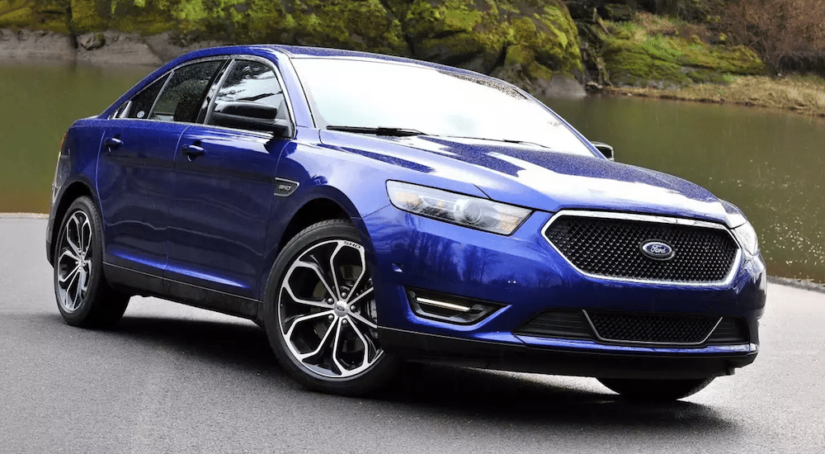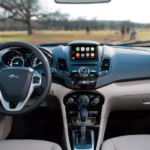When you reach the highest offering within any given segment, automakers have the tendency of painting themselves into a corner. While these vehicles are often well-designed, accurately priced and deserving of accolade they now find themselves attempting to emulate base offerings of more high-end competitors. Not unlike a fighter who struggles to make weight to remain competitive within a lower weight class, these kinds of vehicles walk a set themselves up for failure.
And by blurring the lines some face a bit of an identity crisis, especially from domestic automakers whose offerings range upward from economy compacts. Any vehicle that overshoots its perceived station seems at war with ‘what they are’ and ‘what they are supposed to be’. Using technology as a crutch, many automakers throw the kitchen sink into an aging body style. Turning a blind eye to the fact that relevant styling can mean survival or damnation, especially with the ever-changing nature of consumer taste.
Take the full-size sedan, for example. Once the standard of family vehicles, it has now been relegated to a niche offering. Challenged in the 80’s by minivans, in the 90’s and 00’s by SUVs, and currently, by Crossovers, the marketplace has lamented the inevitable death of the economical full-size sedan for quite some time now. Unenviable in possessing a demographic that could be voted ‘Most Likely to Compromise’ they continue to struggle for relevance; deemed subpar next to luxury midsize and full-sized offerings. Considering the concerns voiced above, a full-sized economy sedan sitting atop the offerings of any automaker finds itself in a precarious position.
The 2017 Ford Taurus is a prime example of such a vehicle, fighting these battles tooth and nail. Adding insult to injury, it is done a further disservice by enduring eight years without a redesign. While some might argue it as a case of ‘if it ain’t broke, don’t fix it’ it becomes dangerous territory for a domestic sedan with three decades and six generations under its belt.
But we’re not here to bury the Taurus. If anything, the 2017 Ford Taurus serves up a great example of how a vehicle can endure, as a result of the battles that it has to face.
A Quick Retrospective
Anyone under the age of 32 has never lived in a world without the Ford Taurus. With the exception of a brief ‘rest’ taken between 2007-2010, the Taurus has remained in production since 1985. In that time, it has taken several forms: sedan and wagon, mid-size and full-size, front-wheel and all-wheel drive. But its inception marked a notable departure in terms of Ford’s endeavors.
First, its rounded design emulated contemporary offerings of higher-end brands such as Audi. This distinctive look was enhanced further Ford’s decision to all but eliminate the grille, as the central focus of the Taurus’ front-end. Referred to as a ‘bottom-breather’ this distinct look helped to immediately distinguish the Taurus from both competitor and stablemates. Finally, the Taurus also represented a shift in Ford’s approach to the drivetrain. Traditionally focused on rear-wheel drive offerings, the front-wheel-drive Taurus (accompanied by the Escort) proved a game-changer.
And the world took note. Introduced in 1986, it would be named MotorTrend ‘Car of the Year’ and among Car and Driver’s ‘10Best’. Remaining a staple among Ford’s offerings, the Taurus continues to stand confidently as Ford’s fifth best-selling vehicle (outsold in ascending order by the Mustang, Model T, Escort and F-150).
And Yet…
I have never known a single person who went out bought a new Ford Taurus. No Facebook friends have ever posted excitedly about owning one and loving it so much. So, is it just me? Is the Taurus’ standing among Ford’s offerings inflated by its early popularity? In short, no…
Ranking 5th among J.D. Power and Associates’ ’10 Most Popular Large Cars’ it falls behind the Chrysler 300, Nissan Maxima, Chevy Impala and (the most popular) Dodge Charger.
So, how does the Taurus measure up in terms of competitor pricing? Well, it falls right in line, priced to start at $27,345. The Chrysler 300 is priced to start at $32,340 MSRP. The Nissan Maxima? From $32,610. The Chevy Impala falls in around $27,500, and the base trim of the favorited Dodge Charger is priced to start around $27,995.
Dead-middle on the list, with no significant pricing disparity, are we left to assume that the Taurus endures out of owner-loyalty and general averageness?
Breaking Down The 2017 Ford Taurus
The 2017 Taurus sits atop Ford’s car offerings, priced to start (above the base-level Mustang) at $27,345 MSRP. Let that sink in for a moment. The V6 Taurus is priced above a V6 Mustang? I can’t be the only one surprised by that.
Then again, the (base) Taurus SE is powered by a 3.5-liter V6 mated to a six-speed automatic transmission. Rated for 288 horsepower and 254 lb-ft of torque, its output falls just shy of the (base) Mustang V6 which offers up 300 hp and 280 lb-ft.
So the Taurus is a confident performer, even at the base trim. And the (top) SHO trim is powered by a 3.5-liter V6 that serves up 365 hp and 350 lb-ft. Considering that fuel-economy ranges from 19-23 mpg (combined, across the Taurus’ three trim levels) the Taurus is inarguably a strong offering in terms of performance.
The Taurus SE comes Bluetooth-enabled, with an infotainment system built around a 4.2-inch display and six-speaker surround system. The display is linked to a rear-few camera, while the sound system offers CD, auxiliary audio jack, and two USB input. While it may not enjoy a touchscreen and Ford Sync3 functionality, jump to the SEL trim and this is corrected, with an 8-inch touchscreen and satellite radio thrown in.
With ample room, strong safety ratings and a smooth ride quality the Taurus meet every expectation of a full-size American sedan. There’s no mistaking it for a luxury sedan, but as you get to know it, there’s not a reason to think that it expects to be. It may still be a bit uninspired in terms of design, but that’s beyond our control (are you listening to Ford execs?)
Regardless, perhaps we need to stop breaking down the Taurus and start building it up.



